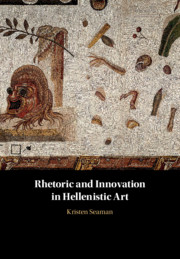Book contents
- Rhetoric and Innovation in Hellenistic Art
- Rhetoric and Innovation in Hellenistic Art
- Copyright page
- Dedication
- Contents
- Illustrations
- Preface
- Abbreviations and Translations
- Chapter One Rhetoric, Innovation, and the Courts
- Chapter Two Narrative in the Telephos Frieze
- Chapter Three Personification in the Archelaos Relief
- Chapter Four Ekphrasis in Sosos’s Unswept Room Mosaic
- Chapter Five Conclusion
- Notes
- Bibliography
- Index
- Plate Section (PDF Only)
Chapter Two - Narrative in the Telephos Frieze
Published online by Cambridge University Press: 16 May 2020
- Rhetoric and Innovation in Hellenistic Art
- Rhetoric and Innovation in Hellenistic Art
- Copyright page
- Dedication
- Contents
- Illustrations
- Preface
- Abbreviations and Translations
- Chapter One Rhetoric, Innovation, and the Courts
- Chapter Two Narrative in the Telephos Frieze
- Chapter Three Personification in the Archelaos Relief
- Chapter Four Ekphrasis in Sosos’s Unswept Room Mosaic
- Chapter Five Conclusion
- Notes
- Bibliography
- Index
- Plate Section (PDF Only)
Summary
The Telephos Frieze (Fig. 2.1) asks a lot of its spectators. Today, the modern viewer must use the Pergamonmuseum in Berlin as a stand-in for the frieze’s original architectural context, the second-century bce Great Altar at Pergamon (Figs. 2.2–2.5). Thinking away the gaps of missing sculpture, and employing the museum’s multilingual handouts, she must figure out the correct order of the frieze’s panels before she can appreciate its narrative. In antiquity, the task of viewing was of course much easier – the frieze was complete and contextualized – but it was far from unchallenging. For centuries, Greek spectators had been accustomed to viewing single moments of action in architectural sculpture. But here, they instead were asked to journey through both time and space in order to follow the life story of one hero, Telephos.
Keywords
- Type
- Chapter
- Information
- Rhetoric and Innovation in Hellenistic Art , pp. 31 - 66Publisher: Cambridge University PressPrint publication year: 2020

